- Cables and adaptors


Circuit Control YDCC-04
The Circuit Control contains four latching (bi-stable) relays, which can be managed from connected control buttons with LED indicators or over NMEA 2000 with standard messages.
The Circuit Control is the core component of our digital switching system. In addition to connected buttons, loads can be managed from modern chart plotters, with "virtual buttons" on the Web Gauges of our Wi-Fi Gateway , or automatically from our sensors. To set up additional control posts with duplicate physical buttons and indication, use Switch Control YDSC-0 4 .

The diagram above shows how the floating switch and the bilge pump are connected to the Circuit Control. The 16-mm button with integrated LED switches the pump between manual and automatic modes, and indicates the actual state. The pump can be also controlled from your smartphone. The Web Gauges page of the NMEA 2000 Wi-Fi Gateway (which is connected to the 2-Way NMEA 2000 connector) is open on the screen. The pump can also be mananged from buttons connected to the Switch Control (also connected to the 2-Way NMEA 2000 connector).
Electrical characteristics of the Circuit Control:
- four channels: two with normally open contacts (ON-OFF) and two with switching contacts;
- latching (bi-stable) relays consume electricity only during the process of switching and stay in their last state after the device is powered off;
- maximum constant load current per channel is 10A, peak is 20A (4 seconds, duty cycle 10%);
- capable of switching the direct current (DC) and alternating current (AC) loads up to 400 V;
- high voltage isolation with a load, 5000 V RMS ;
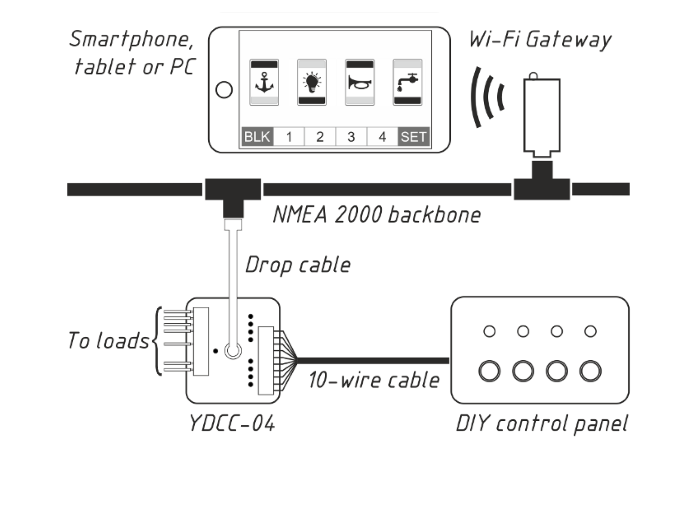
Figures 1-4. System examples
The Circuit Control unit can work in parallel with other units and can be managed from multiple Switch Control units with a matched bank number (252 unique bank numbers are allowed in NMEA 2000). Multiple independent digital switching systems (with different bank numbers) can co-exists in a single NMEA 2000 network. Use the slider shown in the above diagram to check examples of digital switching systems.
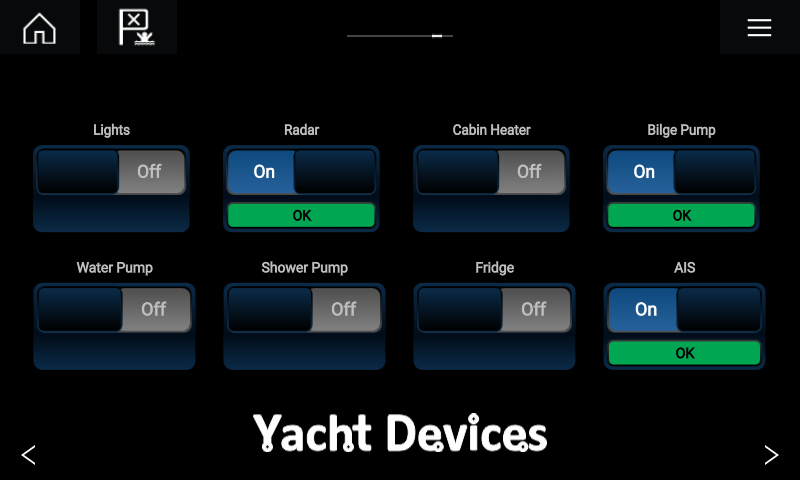
Figure 5. Raymarine Axiom 7" with two YDCC units
You can manage loads connected to the Circuit Control (firmware 1.01 or later is required) from most of modern chart plotters with CZone support. This includes Garmin, Lowrance, Simrad, B&G, Furuno chart plotters and recent models from Raymarine (Axiom, eS and gS series). Click here to configure your MFD . EmpirBus digital switching products (supported in old Raymarine MFDs) are not supported yet.
The Circuit Control and Switch Control are designed to be compatible with Oceanic Systems, Offshore Systems, Chetco Digital, Maretron (see p.27 in the Manual ) and Carling Tech displays and relay modules, and with other NMEA 2000 digital switching devices managed with standard NMEA 2000 PGN 127501 "Binary Status Report" and PGN 127502 "Binary Switch Control".
Product benefits:
- compatible with a wide range of equipment, including modern chart plotterts;
- no special requirements for buttons, you can choose any momentary push buttons to match your boat's interior (see p.19 in the Manual );
- no special knowledge, software or hardware is required for installation;
- price and size are suitable for small vessels;
- any type of load is allowed (AC, DC, audio);
- no heating, no extra power consumption;
- pure NMEA 2000 product, compliant to the Standard and certified by NMEA ;
- high-voltage isolation with the load;
- support firmware updates, free software for PC is available (Wi-Fi or USB Gateway is required).
User Manual (PDF)
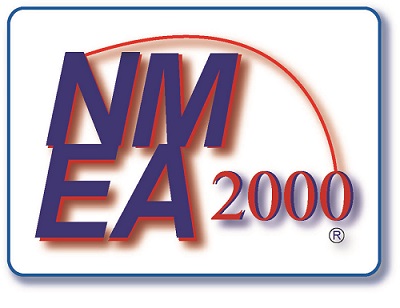
Figure 5. Drawing of Circuit Control YDCC-04
For additional technical details, please see the User Guide and FAQ .
- choosing a selection results in a full page refresh

- Electronics
- GPS, Finders & Accessories
- Sports & Handheld GPS
- Handheld GPS Units
Add to your order

- No Additional Cost: You pay nothing for repairs – parts, labor, and shipping included.
- Coverage: Malfunctions covered after the manufacturer's warranty.
- Easy Claims Process: File a claim anytime online or by phone. Most claims approved within minutes. If we can’t repair it, we’ll send you an Amazon e-gift card for the purchase price of your covered product or replace it.
- Product Eligibility: Plan must be purchased with a product or within 30 days of the product purchase. Pre-existing conditions are not covered.
- Terms & Details: More information about this protection plan is available within the “Product guides and documents” section. Simply click “User Guide” for more info. Terms & Conditions will be available in Your Orders on Amazon. Asurion will also email your plan confirmation with Terms & Conditions to the address associated with your Amazon account within 24 hours of purchase.
- Buy a lot of stuff on Amazon? Tons of items eligible for coverage, from the latest tech like Laptops, Game Consoles, TVs, Phones, and Cameras to major appliances, sporting goods, tools, toys, personal care, furniture, and more.
- Accidents Happen. That’s why for your portable products we cover accidental damage from handling such as drops, spills and cracked screens. We also cover electrical and mechanical malfunctions, power surges, and wear and tear.
- Past and Future Purchases covered. 30 days after you are enrolled, all eligible past purchases (up to 1 year prior to enrollment) and future eligible purchases made on Amazon will be covered by your plan as long as you are enrolled.
- Fast, easy claims. Frustration-Free claims, with most filed in minutes. We will fix it, replace it, or reimburse you with an Amazon e-gift card for the purchase price of your product (excluding tax). File at Asurion.com/amazon.
- No Hidden Fees. For just $16.99 a month + tax you’re covered for up to $5,000 in claims per 12-month period. *THIS PROGRAM IS MONTH-TO-MONTH AND WILL CONTINUE UNTIL CANCELED* Coverage for all products ends 30 days after the plan is canceled. Cancel any time.

Enjoy fast, free delivery, exclusive deals, and award-winning movies & TV shows with Prime Try Prime and start saving today with fast, free delivery
Amazon Prime includes:
Fast, FREE Delivery is available to Prime members. To join, select "Try Amazon Prime and start saving today with Fast, FREE Delivery" below the Add to Cart button.
- Cardmembers earn 5% Back at Amazon.com with a Prime Credit Card.
- Unlimited Free Two-Day Delivery
- Streaming of thousands of movies and TV shows with limited ads on Prime Video.
- A Kindle book to borrow for free each month - with no due dates
- Listen to over 2 million songs and hundreds of playlists
- Unlimited photo storage with anywhere access
Important: Your credit card will NOT be charged when you start your free trial or if you cancel during the trial period. If you're happy with Amazon Prime, do nothing. At the end of the free trial, your membership will automatically upgrade to a monthly membership.
Return this item for free
We offer easy, convenient returns with at least one free return option: no shipping charges. All returns must comply with our returns policy.
- Go to your orders and start the return
- Select your preferred free shipping option
- Drop off and leave!
2 Year Portable Electronic Accident Protection Plan
3 year portable electronic accident protection plan, asurion complete protect: one plan covers all eligible past and future purchases on amazon.

Image Unavailable

- To view this video download Flash Player
Yacht Devices Circuit Control - YDCC-04N
Purchase options and add-ons
| Brand | Yacht Devices |
| Model Name | Boat Circuit Control |
| Connectivity Technology | Wi-Fi |
| Included Components | Boat Circuit Control |
| Human Interface Input | Buttons |
| Are Batteries Included | No |
| Manufacturer | Yacht Devices |
About this item
- four channels: two with normally open contacts (ON-OFF) and two with switching contacts
- latching (bi-stable) relays consume electricity only during the process of switching and stay in their last state after the device is powered off
- maximum constant load current per channel is 10A, peak is 20A (4 seconds, duty cycle 10%)
- capable of switching the direct current (DC) and alternating current (AC) loads up to 400 V
- average device consumption is only 30 mA
Buy it with

Similar items that ship from close to you

Product Description
The Circuit Control contains four latching (bi-stable) relays, which can be managed from connected control buttons with LED indicators or over NMEA 2000 with standard messages. The Circuit Control is the core component of our digital switching system. In addition to connected buttons, loads can be managed from modern chart plotters, with "virtual buttons" on the Web Gauges of our Wi-Fi Gateway, or automatically from our sensors. To set up additional control posts with duplicate physical buttons and indication, use Switch Control YDSC-04.
Product information
Technical details.
| Item Package Dimensions L x W x H | 4.61 x 3.46 x 1.69 inches |
|---|---|
| Package Weight | 0.25 Kilograms |
| Brand Name | Yacht Devices |
| Warranty Description | 1 year limited warranty |
| Model Name | Boat Circuit Control |
| Color | Black |
| Material | Plastic |
| Suggested Users | unisex-adult |
| Manufacturer | Yacht Devices |
| Part Number | NYD-018 |
| Included Components | Boat Circuit Control |
Additional Information
| ASIN | B07LFKGP7G |
|---|---|
| Customer Reviews | 5.0 out of 5 stars |
| Best Sellers Rank | #533,562 in Electronics ( ) #1,130 in |
| Date First Available | June 21, 2019 |
Looking for specific info?
Customer reviews.
- 5 star 4 star 3 star 2 star 1 star 5 star 100% 0% 0% 0% 0% 100%
- 5 star 4 star 3 star 2 star 1 star 4 star 100% 0% 0% 0% 0% 0%
- 5 star 4 star 3 star 2 star 1 star 3 star 100% 0% 0% 0% 0% 0%
- 5 star 4 star 3 star 2 star 1 star 2 star 100% 0% 0% 0% 0% 0%
- 5 star 4 star 3 star 2 star 1 star 1 star 100% 0% 0% 0% 0% 0%
Customer Reviews, including Product Star Ratings help customers to learn more about the product and decide whether it is the right product for them.
To calculate the overall star rating and percentage breakdown by star, we don’t use a simple average. Instead, our system considers things like how recent a review is and if the reviewer bought the item on Amazon. It also analyzed reviews to verify trustworthiness.
No customer reviews
- Amazon Newsletter
- About Amazon
- Accessibility
- Sustainability
- Press Center
- Investor Relations
- Amazon Devices
- Amazon Science
- Sell on Amazon
- Sell apps on Amazon
- Supply to Amazon
- Protect & Build Your Brand
- Become an Affiliate
- Become a Delivery Driver
- Start a Package Delivery Business
- Advertise Your Products
- Self-Publish with Us
- Become an Amazon Hub Partner
- › See More Ways to Make Money
- Amazon Visa
- Amazon Store Card
- Amazon Secured Card
- Amazon Business Card
- Shop with Points
- Credit Card Marketplace
- Reload Your Balance
- Amazon Currency Converter
- Your Account
- Your Orders
- Shipping Rates & Policies
- Amazon Prime
- Returns & Replacements
- Manage Your Content and Devices
- Recalls and Product Safety Alerts
- Registry & Gift List
- Conditions of Use
- Privacy Notice
- Consumer Health Data Privacy Disclosure
- Your Ads Privacy Choices

NMEA 2000 Circuit Control YDCC-04

The NMEA 2000 Circuit Control YDCC-04 from Yacht Devices allows digital switching of up to 4 AC/DC channels via latching relays from your chart plotter, web page or connected buttons.

The NMEA 2000 Circuit Control YDCC-04 is the core of the digital switching system. As well as connected buttons, loads can be managed from modern chart plotters, or from virtual buttons on the web gauges of our Wi-Fi gateway or automatically from sensors. You can use the NMEA 2000 Switch Control YDSC-04 in addition to duplicate physical buttons and indicators remotely.

The image above shows how the float switch of the bilge pump and the bilge pump are connected to the circuit control. The button with integrated LED switches the bilge pump between manual and automatic modes, and indicates the actual state. The bilge pump could also be controlled from your mobile device using the webpages within the NMEA 2000 Wi-Fi Gateway (which is connected to the 2-way NMEA 2000 connector). The pump can also be managed from buttons connected to the Yacht Devices Switch Control (YDSC-04).
Electrical Characteristics
- Four channels; two with normally open contacts (ON-OFF) and two with switching contacts
- Latching (bi-stable) relays consume electricity only during the process of switching and stay in their last state after the device is powered off.
- Maximum constant load current per channel is 10A, peak is 20A (4 seconds duty cycle 10%)
- Capable of switching the direct current (DC) and alternating current (AC) loads up to 400V
- High voltage isolation with a load, 5000V RMS
- Average device consumption is only 30mA

The Yacht Devices NMEA 2000 Circuit Control YDCC-04 can work in parallel with other units and be managed from multiple switch control units with a matched bank number. Multiple independent digital switching systems (with different bank numbers) can co-exist in one NMEA 2000 network.

You can manage the loads connected to the Circuit Control from most modern chart plotters with CZone support. This includes Garmin, Lowrance, Simrad, B&G, Furuno and recent models from Raymarine (Axiom, eS and gS series). EmpirBus digital switching products are not yet supported.
The Circuit Control and Switch Control devices are designed to be compatible with Oceanic Systems, Offshore Systems, Chetco Digital, Marathon and Carling Tech displays and relay modules, and with other NMEA 2000 digital switching devices managed with PGN 127501 “Binary Status Report” and PGN 127502 “Binary Switch Control”
- Compatible with a wide range of equipment.
- No special button requirements. You can choose any momentary push buttons to match your boats interior.
- No special knowledge, software or hardware is required for installation
- Any type of load is supported, (AC or DC, audio)
- No heating, no extra power consumption
- Pure NMEA 2000 product, compliant to the standard
- High voltage isolation with the load.

Yacht Devices YDCC-04N Circuit Control Micro Male, 4 x Bistable Relay
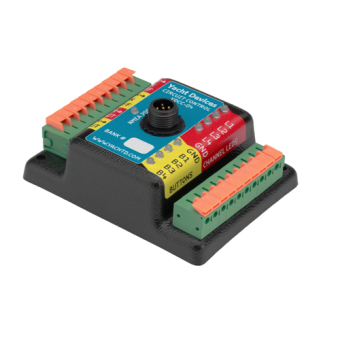
- Description
Ask a Question
The Yacht Devices YDCC-04N Circuit Control is a core component of digital switching systems, providing seamless management of onboard electrical circuits. Equipped with four latching (bi-stable) relays, it allows control via connected buttons with LED indicators or over the NMEA 2000 network using standard messages.
Key Features
- Latching Relays: Four channels: two with normally open contacts (ON-OFF) and two with switching contacts.
- Efficient Power Use: Latching relays consume electricity only during the switching process and maintain their last state after power off.
- High Capacity: Maximum constant load current per channel is 10A, with a peak of 20A (for 4 seconds, duty cycle 10%).
- Versatile Load Support: Capable of switching both direct current (DC) and alternating current (AC) loads up to 400V.
- High Voltage Isolation: Provides 5000 VRMS isolation with the load.
- Low Power Consumption: Average device consumption is only 30 mA.
Integration and Control
The Circuit Control integrates with various control systems, allowing management from modern chart plotters, Web Gauges on Wi-Fi Gateways, or automatically from connected sensors. To set up additional control posts with duplicate physical buttons and indications, use the Switch Control YDSC-04 .
The Circuit Control unit can operate in parallel with other units and can be managed from multiple Switch Control units with a matched bank number. Multiple independent digital switching systems can coexist in a single NMEA 2000 network.
System Examples
- Basic System: Single Circuit Control unit setup.
- Typical System: Multiple control panels integrated.
- Parallel Loads: Synchronized Circuit Control units managing parallel loads.
- Independent Systems: Two independent digital switching systems with different bank numbers.
Compatibility
The Circuit Control (firmware 1.01 or later) is compatible with most modern chart plotters supporting CZone, including Garmin, Lowrance, Simrad, B&G, Furuno, and recent Raymarine models. It is also compatible with Oceanic Systems, Offshore Systems, Chetco Digital, Maretron, and Carling Tech displays and relay modules, and other NMEA 2000 digital switching devices managed with standard NMEA 2000 PGN 127501 "Binary Status Report" and PGN 127502 "Binary Switch Control".
Product Benefits
- Compatible with a wide range of equipment, including modern chart plotters.
- No special requirements for buttons; any momentary push buttons can be used.
- Easy installation with no special knowledge, software, or hardware required.
- Suitable for small vessels due to its size and cost-effectiveness.
- Supports any type of load (AC, DC, audio) without heating or extra power consumption.
- Pure NMEA 2000 product, compliant with the standard and certified by NMEA.
- High-voltage isolation with the load and supports firmware updates.
Package Includes
- Circuit Control YDCC-04N
- User Manual
For additional technical details, please refer to the User Guide and FAQ.
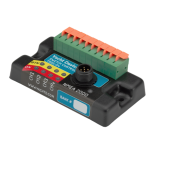
- Personal Recommendations

Switch Control - NMEA 2000 Switch Control for Digital Switching - YDSC-04
Regular price $159.00
Switch Control YDSC-04
The Switch Control allows viewing of the state and the management of four channels of an NMEA 2000 switch bank from the connected buttons with LED indicators.
It is designed to work in tandem with Circuit Control YDCC-04 (contains four latching relays) and is compatible with other NMEA 2000 digital switching devices managed by standard NMEA 2000 PGNs 127501 and 127502.
The Device has terminals for connecting four momentary push buttons with an LED indicator. External buttons are not supplied with this device; you can choose any to match your boat's interior ( see the Manual for recommendations).
The Circuit Control and Switch Control are designed to be compatible with Oceanic Systems , Offshore Systems, Chetco Digital, Maretron (see p.27 in the Manual ) and Carling Tech displays and relay modules, and with other NMEA 2000 digital switching devices managed with standard NMEA 2000 PGN 127501 "Binary Status Report" and PGN 127502 "Binary Switch Control".
You can also manage loads connected to the Circuit Control from most modern chart plotters with CZone support .
Product benefits:
- no special requirements for buttons, you can choose any momentary push buttons to match your boat's interior (see p.19 in the Manual );
- special "split mode" to control two Circuit Control units;
- no special knowledge, software or hardware is required for installation;
- price and size are suitable for small vessels;
- pure NMEA 2000 product, compliant to the Standard and certified by NMEA ;
- support firmware updates, free software for PC is available ( Wi-Fi or USB Gateway is required).

Deal of the day


Yacht Devices Circuit Control NMEA 2000 Digital Switching YDCC-04
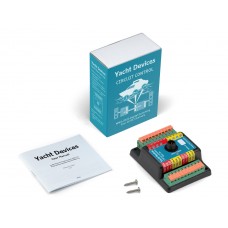
- Description
The Circuit Control unit has four latching (bi-stable) relays, which can be managed from connected control buttons with LED indicators or over NMEA 2000 with standard messages or from modern chart plotters with CZone support. This includes Garmin, Lowrance, Simrad, B&G, Furuno chart plotters and recent models from Raymarine (Axiom, eS and gS series). Loads can also be managed with "virtual buttons" on the Web Gauges of our Wi-Fi Gateway, or automatically from our sensors.
- Brand: Yacht Devices
- Product Code: YDCC-04
- Availability: In Stock
Tags: Digital Switching , NMEA 2000
- About The Journalist’s Resource
- Follow us on Facebook
- Follow us on Twitter
- Criminal Justice
- Environment
- Politics & Government
- Race & Gender
Expert Commentary
Understanding the Chechen conflict: Research and reading list
2013 review of Chechnya-related scholarship and the conflict and political grievances there that continue to reverberate.
Republish this article

This work is licensed under a Creative Commons Attribution-NoDerivatives 4.0 International License .
by Alexandra Raphel, The Journalist's Resource April 22, 2013
This <a target="_blank" href="https://journalistsresource.org/politics-and-government/understanding-chechen-conflict-research-roundup-reading-list/">article</a> first appeared on <a target="_blank" href="https://journalistsresource.org">The Journalist's Resource</a> and is republished here under a Creative Commons license.<img src="https://journalistsresource.org/wp-content/uploads/2020/11/cropped-jr-favicon-150x150.png" style="width:1em;height:1em;margin-left:10px;">
News that the primary suspects in the April 15 Boston Marathon bombings are of Chechen heritage resurrected interest in historically troubled Chechnya, an autonomous republic in Russia’s North Caucasus Region. Suspects Dzhokhar and Tamerlan Tsarnaev’s motive has yet to be confirmed, but questions abound about what role the ongoing violence between Russia and Chechen separatists might have played.
Of course, precise connections are speculative, and the media has already been criticized for making too quick a leap — and for perpetuating stereotypes about Chechens and Muslims in general . Charles King’s article in Foreign Affairs , “Not Your Average Chechen Jihadis,” provides further insights on these points. London School of Economics scholar Jim Hughes offers compelling perspective .
Fiona Hill, director of the Center on the United States and Europe at the Brookings Institution , writes , “Chechnya and Russia have spent centuries at war and it isn’t surprising that this conflict, which has spanned generations, would provide fertile ground to incite and radicalize sympathizers wherever they happen to live.” Hill also provides an overview of the conflict in an interview titled “The Troubled History of Chechnya.”
Although the region has, for the most part, stayed out of the Western media headlines in recent years, reverberations of the conflict are still being felt both in the region and among the global diaspora. Thomas de Waal, a Russia expert at the Carnegie Endowment for International Peace, notes in a recent article that “a low-level Islamist insurgency continues in and around Chechnya that takes dozens of lives each year.” For a sense of recent activity in the region, see “Islam, Islamism, and Politics in Eurasia Report,” published in March 2013 by Center for Strategic and International Studies.
The ongoing animosity between the largely Muslim ethnic Chechens and the Russian government dates back to Russo-Persian War (1804-1813), when Persia transferred the territory to Russian control. After years of attempted revolt by the Chechens, in 1944 Soviet Leader Josef Stalin deported the entire population of the North Caucasus — people in the republics of Ingushetia, Chechnya and North Ossetia — to Central Asia, claiming that they were collaborating with Nazi Germany.
After the fall of the Soviet Union in 1991, Chechen separatists called for independence from Moscow and two bloody wars followed during the following decade. The second ended in 2000 when Russian forces captured the Chechen capital of Grozny. Since then, Chechen separatists have continued to engage in acts of terrorism, including the 2002 hostage drama at a Moscow theater, capture of a school in 2004 and the 2010 bombing of a Moscow metro station .
For more information on the Chechen conflict and recent Russian history, see the Council on Foreign Relations’ “Backgrounder on Chechen Terrorism” and the article “What to Read on Russian Politics” in Foreign Affairs .
Below is a selection of papers, reports and articles that can provide further context on the conflict:
“The Rise of Radical and Nonofficial Islamic Groups in Russia’s Volga Region” Markedonov, Sergey. Center for Strategic and International Studies, January 2013.
Summary: “In the two decades since the dissolution of the USSR, Russian and Western experts, human rights activists, and journalists have become accustomed to the political violence of the North Caucasus. Terrorist bombings and acts of sabotage in Dagestan, Ingushetia, and Chechnya are perceived as somehow intrinsic to the region. But a recent tragedy in the Volga region suggests that this sort of violence — and the Islamist terrorists who perpetrate it — may not be confined to the Caucasus. To examine this increasingly serious situation, this report sheds light on the ideological sources and resources of radicalism in the Volga region, nonofficial Islamic movements’ support among the regional population, and opportunities for the potential growth of different forms of Islamist activities. It describes the origins of different nonofficial Islamic movements, as well as their post-Soviet development, ideology, and relationship with the authorities and official Muslim clergy. The report also offers practical approaches both for Russian domestic policy and for the U.S.-Russia security cooperation agenda.”
“Russia’s Homegrown Insurgency: Jihad in the North Caucasus” Blank, Stephen J. Strategic Studies Institute, October 2012.
Summary: “The three papers offered in this monograph provide a detailed analysis of the insurgency and counterinsurgency campaigns being conducted by Islamist rebels against Russia in the North Caucasus. This conflict is Russia’s primary security threat, but it has barely registered on Western minds and is hardly reported in the West as well. To overcome this neglect, these three papers go into great detail concerning the nature of the Islamist challenge, the Russian response, and the implications of this conflict. This monograph, in keeping with SSI’s objectives, provides a basis for dialogue among U.S., European, and Russian experts concerning insurgency and counterinsurgency, which will certainly prove useful to all of these nations, since they will continue to be challenged by such wars well into the future. It is important for us to learn from the insurgency in the North Caucasus, because the issues raised by this conflict will not easily go away, even for the United States as it leaves Afghanistan.”
“Prisoners of the Caucasus: Russia’s Invisible Civil War” King, Charles; Menon, Rajan. Foreign Affairs , July/August 2010.
Summary: “A pernicious mix of heavy-handed rule, corrupt governance, high unemployment, and militant Islam has reignited the Russian North Caucasus. Today, it is not only the old conflict zone of Chechnya but also its neighboring republics that are bordering on open civil war.”
“The New Chechen Jihad: Militant Wahhabism as a Radical Movement and a Source of Suicide Terrorism in Post-War Chechen Society” Speckhard, Anne; Akhmedova, Khapta. Democracy and Security , Vol. 2, Issue 1, 2006.
Abstract: The first act of Chechen suicide terrorism occurred on June 7, 2000, and was carried out by two young women. This inaugurated the migration of suicide terrorism from other conflict zones, into the Chechen conflict. How suicide terrorism as a tactic made its way into Chechnya is the topic of this paper, which provides an analysis of the events concerning the importation of militant ideologies and radical terrorist movements taking place since the Chechen declaration of independence as well as an empirical and theoretical analysis of Chechen suicide terrorism based on psycho-social interviews that were collected in Chechnya over a two-year time period from March 2003 to March 2005. We report data about suicide terrorism and the radicalization process from 32 interviews with family members and close associates of thirty-four Chechen suicide terrorists, inquiring about the terrorists’ backgrounds, experiences, religious, and psychological reasons leading up to their suicidal acts.
“Russia’s Ruinous Chechen War” Menon, Rajan; Fuller, Graham. Foreign Affairs , March/April 2000.
Summary: “The Russian Federation is unraveling, and its war against Chechnya shows why. Moscow blames Islamist terrorists for the trouble there. But in doing so, it ignores Russia’s deeper afflictions. Russia has forced disparate ethnic groups to live together for decades but has proven inept at governing its wobbly empire. Now the fighting in Chechnya is leading dissatisfied nationalities to rethink their options — and their dependence on Russia. Chechnya was the first to rebel. It will not be the last.”
“Russia’s Invasion of Chechnya: A Preliminary Assessment” Blank, Stephen J.; Tilford, Earl H. Jr. Strategic Studies Institute, January 1995.
Brief Synopsis: “On December 11, 1994, Russia invaded the secessionist republic of Chechnya in the North Caucasus. The aim was to suppress the republic’s government, led by General Dzhokar Dudayev, compel it to accept Moscow’s authority, and to force it to renounce its bid for independence and sovereignty. This invasion, which quickly turned into a military quagmire for Russia’s troops, triggered a firestorm of domestic opposition, even within the higher levels of the Ministry of Defense. As a result, the invasion has the most profound and troubling possible consequences for the stability of the Russian government, Russian democracy, and the future political-military relationship. This special report, based on what is already known, attempts to assess the discernible consequences of this invasion and provide a framework within which future developments can be assessed.”
“The North Caucasus: Russia’s Volatile Frontier” Kuchins, Andrew C.; Markedonov, Sergey. Center for Strategic and International Studies, March 2011.
Synopsis: “Continued violence and unrest in the North Caucasus have created a major area of instability for the Russian Federation. Although Chechnya is relatively more stable, for now, under the brutal dictatorship of Ramzan Kadyrov, neighboring republics including Ingushetia, Dagestan, and others have experienced significant increases in the frequency of violence. The entire region is plagued by extreme poverty, high unemployment, and corrupt and often incompetent governance. Additionally, the prevalence of radical Islamic influences as well as growing competitive nationalist identities further increases the challenges for governance and stability. The Russian federal government seeks to insulate the rest of the country from the overflow of violence in this volatile region, but terrorist attacks in the past year on the Moscow Metro and again on the train between Moscow and St. Petersburg demonstrate how hard this is to manage. Kuchins, Malarkey, and Markedonov examine the socioeconomic trends in the region, the role of Islam and rise of radicalism throughout the Caucasus, nationalism and growing ethnic tensions, and the external factors influencing the North Caucasus.”
“Radical Islam in the North Caucasus: Evolving Threats, Challenges, and Prospects” Markedonov, Sergey. Center for Strategic and International Studies, November 2010.
Synopsis: “As Kyrgyzstan plunges into crisis and the threat of a second Afghanistan in Central Asia looms large, the situation in the “Big Caucasus” seems less pressing and thus overshadowed. The worst scenarios predicted by analysts and politicians for the period of the 2008 August war have not been realized. The Russian attempt to “replace the regime” of Mikhail Saakashvili or apply the Georgian pattern in Ukraine, expected by many in the West, has not taken place. Neither have the attempts from the West (the United States, NATO, and others) to “nudge Georgia into a rematch,” which were expected in Moscow. Nonetheless, the Caucasus region remains one of the most vulnerable spaces in Eurasia. What challenges have turned the North Caucasus into a primary issue for Russia? Could we paint the political, ideological, and psychological portrait of the North Caucasus militant resistance? What resources do they have, and why has radicalism becomes popular? What external and internal factors determine their approaches? What mistakes did Russia, its society, and the Western observers make? And, finally, could the rise of Islamist militancy in the North Caucasus bring Moscow and Washington closer, regardless of the numerous foreign policy disputes existing between the two countries? This report is an attempt to answer these questions. It is based on open sources and interviews made during several trips to the North Caucasus republics, and it aims to promote more practical approaches to the situation there.”
“Conflicts in the Caucasus: Prospects for Resolution” Testimony by Fiona Hill before the U.S. Helsinki Commission, December 2011.
Excerpt: “The Helsinki Commission has an important role to play in advancing peace and democracy throughout the world. Unfortunately today, even in what might be considered an enlightened time, many people still face war and oppression in their homes. One of the regions that still witnesses much conflict is the Caucasus, with disputes in Georgia, Russia, Chechnya and others. The quest for peace is ongoing and certainly a worthwhile goal. Today, I hope to hear from the witnesses about the latest developments in the Caucasus. I would like to hear about what actions the countries within the region are taking to ease tensions. I’d also like to learn what the other Helsinki Commission countries are doing to help, as well as what the role the witnesses believe that us here in the United States House of Representatives, where we could be helpful.”
“Connectedness, Social Support and Internalising Emotional and Behavioural Problems in Adolescents Displaced by the Chechen conflict” Betancourt, Theresa S. et al. Disasters , 36(4), 2012.
Abstract: “ The study investigated factors associated with internalising emotional and behavioural problems among adolescents displaced during the most recent Chechen conflict. A cross-sectional survey (N=183) examined relationships between social support and connectedness with family, peers and community in relation to internalising problems. Levels of internalising were higher in displaced Chechen youth compared to published norms among non-referred youth in the United States and among Russian children not affected by conflict. Girls demonstrated higher problem scores compared to boys. Significant inverse correlations were observed between family, peer and community connectedness and internalising problems. In multivariate analyses, family connectedness was indicated as a significant predictor of internalising problems, independent of age, gender, housing status and other forms of support evaluated. Sub-analyses by gender indicated stronger protective relationships between family connectedness and internalising problems in boys. Results indicate that family connectedness is an important protective factor requiring further exploration by gender in war-affected adolescents.”
Tags: terrorism, research roundup
About The Author
Alexandra Raphel
Chechnya, Russia and 20 years of conflict
How the tiny region shaped post-Soviet Russia on the 20th anniversary of the start of first Chechnya war.
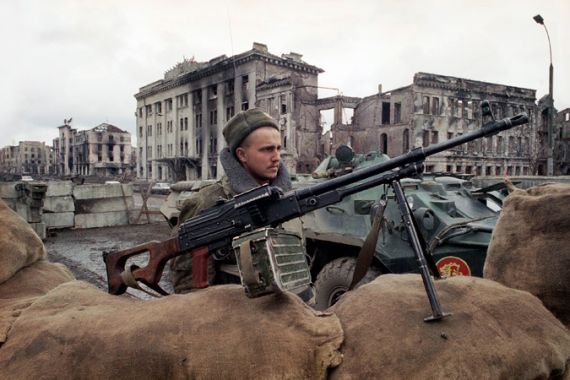
Moscow, Russia – Twenty years ago on Thursday, Moscow started what it thought would be a “blitzkrieg” against secular separatists in Chechnya, a tiny, oil-rich province in Russia’s North Caucasus region that had declared its independence.
But the first Chechen war became Russia’s Vietnam; the second war was declared a victory only in 2009. The two conflicts have reshaped Russia, Chechnya, their rulers – and those who oppose them.
In 1994, s hortly after Moscow invaded Chechnya in an effort to restore its territorial integrity, Akhmad Kadyrov, a bearded, barrel-chested Muslim scholar turned guerrilla commander, declared jihad on all Russians and said each Chechen should kill at least 150 of them.
That was the proportion of the populations on each side of the conflict: some 150 million Russians and less than a million Chechens in a small, landlocked province, which the separatists wanted to carve out of Russia.
Western media and politicians dubbed the Chechens “freedom fighters” – an army of Davids fighting the Russian Goliath.
Moscow was lambasted internationally for disproportionate use of force and rolling back on the democratic freedoms that former leader Boris Yeltsin was so eager to introduce after the 1991 Soviet Union collapse.
Tens of thousands died amid atrocities committed by both sides – and many more were displaced before 1996, when the Russians retreated, leaving Chechnya essentially independent.
Retreating was a humiliation for Russia’s military machine that less than a decade earlier had presented a seemingly formidable threat to the entire Western world.
Chechen against Chechen
Independence did not quite work out for the Chechens. The separatist government based in the ruined capital, Grozny, lost control over the rest of Chechnya.
Feuding field commanders and foreign jihadists, such as the Saudi known as Emir al-Khattab, ruled small districts with their own little armies. Kidnappings for ransom – along with primitive extraction of oil – were their main sources of income.
Many of the foreigners adhered to a puritanical Muslim ideology known as Wahhabism that ran counter to Chechnya’s Sufi traditions.
Akhmad Kadyrov, who was appointed as top Mufti of Chechnya, came into opposition with the puritans and their Chechen supporters, because he saw their extremist views as a threat to the separatist movement. In 1998, Kadyrov openly renounced the Wahhabis – and barely survived the first of many assassination attempts.
Kadyrov soon switched alliances, siding with the people upon whom he had once declared war – the Russians.
A virtually unknown ex-KBG officer, Vladimir Putin became Russia’s new prime minister i n August 1999 and w ithin weeks led a military operation against the Chechen fighters.
RELATED: Timeline: Attacks in Russia
When a series of explosions in apartment buildings in Moscow and two Russian towns killed more than 300 Russians, Moscow blamed Chechen rebels and embarked on an epic “anti-terrorist operation,” which became the second Chechen war.
Putin’s approval ratings skyrocketed, paving the way for his first presidency. A ided by Kadyrov and other Chechen clans who had pledged allegiance to the Kremlin, t he Russian military quickly returned most of Chechnya to Moscow’s control. In 2003, Kadyrov was elected Chechen president.
Russian targets
Cornered in Chechnya, the separatists took the war to Russia.
Attacks throughout the country became a grim reality of the new war and involved explosions in cities and towns, on planes and public transport.
At least two dozen attacks were carried out by female suicide bombers. Dubbed “black widows”, they became a sinister image imprinted on Russia’s collective psyche.
One such attack killed Akhmad Kadyrov in May 2004. His son, 27-year-old Ramzan Kadyrov, was too young to run for president at the time, but as head of his father’s security service, he quickly became Chechnya’s de facto ruler. I n 2007, soon after he turned 30, the younger Kadyrov was elected president.
Four months after his father’s assassination, Chechen separatists seized a public school in the town of Beslan taking more than 1,000 hostages, mostly children. Almost 200 kids died when Russian forces stormed the school. The incident changed the world’s attitude towards the Chechen cause – “freedom fighters” became “Islamic insurgents” in the Western media.
Meanwhile, the media in Russia came under attack.
“The saying was that it was journalists who won the first Chechen war,” says Tatyana Lokshina, deputy director of the Moscow branch of Human Rights Watch, an international rights watchdog.
Moscow used unfavourable media coverage of the war as an excuse to curtail press freedoms. The Kremlin took over all national television networks and most major newspapers.
| [AP] |
“For years, Vladimir Putin saw the pacification of Chechnya as his main achievement,” says Stanislav Belkovsky, a Moscow-based political analyst . “In that respect, Putin has a colossal psychological dependency on Chechnya and Ramzan Kadyrov who ensured the pacification.”
The Beslan crisis also served as a pretext to tighten political screws in Russia. Putin eliminated regional gubernatorial elections, complicated participation of opposition parties in elections, and limited democratic freedoms.
The public hailed Putin for bringing stability and pacifying Chechnya. The victory revived Moscow’s imperial ambitions – at least in the area of the former Soviet Union.
Shaping today’s Russia
Moscow won the brief 2008 Russo-Georgian war over the breakaway Georgian province of South Ossetia . In March 2014, Russia took over Crimea from Ukraine and helped unleash a civil war between pro-Russian separatists and the central Ukrainian government just a month later.
Both Chechen wars became systemic factors in shaping today's Russia. Instead of peaceful development inside the country we moved to the priority of external expansion by - Stanislav Belkovsky, political analyst
“Both Chechen wars became systemic factors in shaping today’s Russia,” says Belkovsky . “Instead of peaceful development inside the country, we moved to the priority of external expansion.”
Putin declared “the counter-terrorism operation” in Chechnya over in 2009 – just when things in North Caucasus took a turn for the worse.
Dagestan and several other provinces in the region became the new hotbeds of radical Islamism. A new generation of Moscow’s foes did not want secular separation – instead they are fighting to establish a “Caucasus Emirate” that includes adjacent Russian regions with sizable Muslim populations.
At least 529 people were killed and 457 wounded in North Caucasus in 2013, according to Kavkazsky Uzel, a Russian web portal that monitors the situation in the region. The confrontation has turned into “Europe’s most active armed conflict ” , according to the International Crisis Group, a conflict-monitoring organisation.
The insurgency became self-sustaining because of a vicious circle perpetuated by corruption and brutality.
Federal forces and police trigger the violence with extra-judicial killings, arrests, kidnappings and other abuses, according to rights groups and critics. They claim young men have no other options but to join the rebels because corrupt officials blacklist their families to extort bribes.
The fighters, in turn, blackmail corrupt officials who embezzle lavish funds from Moscow. The practise involves “sending a flash card” containing a video message in which bearded men demand a “jihad tax”.
Storming Grozny again
Ramzan Kadyrov was, perhaps, the least attentive man in the crowd of about 1,100 officials in an opulent Kremlin hall on December 4 during Putin’s annual address. The stocky 38-year-old Chechen leader fidgeted in his seat and constantly checked his phone.
Just hours before the Kremlin ceremony, a dozen Islamist fighters attacked Grozny, Chechnya’s newly-rebuilt capital. Shootouts in a publishing house, an empty school, and an office building killed 11 insurgents and 14 law enforcement officers.
A day after the attack, Kadyrov said the attackers’ families should be thrown out of Chechnya, their houses destroyed. At least six houses that belonged to relatives of the Grozny attackers have been burned down by masked men, Lokshina of Human Rights Watch said.
Kadyrov’s threats were not new to Chechens. During the second Chechen war, he led paramilitary squads known as kadyrovtsy that soon gained notoriety for abducting, torturing and killing separatists and civilians suspected of aiding them, according to human rights groups and survivors.
| that soon gained notoriety for abducting, torturing and killing separatists and civilians [AFP] |
A string of his political enemies and critics, including a former bodyguard, an investigative reporter, and a human rights activist have been gunned down in Chechnya, Moscow, Austria, and Dubai.
Kadyrov denied involvement in the contract-style killings.
Over the years, Kadyrov developed a penchant for luxury – he has a private zoo, race horses, and numerous sports cars. Pop stars, Hollywood actors and sportsmen show up at concerts held on his birthday.
His portraits are seen on billboards, government buildings and schoolchildren’s lapel pins; while streets, schools, mosques and military units are named after his father and mother.
Whatever he does is breaking news on Chechen television – he is shown threatening rebels and corrupt officials, boxing with his ministers, welcoming foreign dignitaries,and bestowing money, apartments and cars upon average Chechens.
Some say Kadyrov’s lifestyle and political ways make him look like an eccentric sovereign, not a public official on the Kremlin payroll.
“Today, Chechnya is a de facto independent state,” says Belkovsky. “Although formally [Kadyrov] shows loyalty to Putin and formally Chechnya is part of Russia.”
Yacht Devices
sailors for sailors
December 6, 2018 New digital switching products
We are very pleased to present the Circuit Control YDCC-04 and the Switch Control YDSC-04. These devices have low power consumption and are cost effective and well suited to building a NMEA 2000 digital switching system on small and medium size vessels.
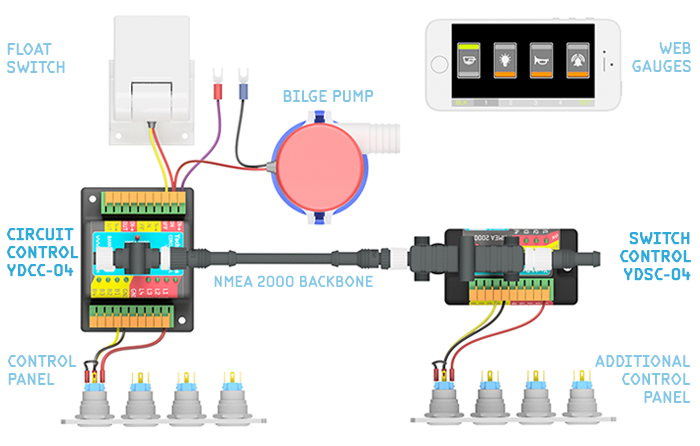
The main key to successful sailing is knowledge of your boat. You must know her possibilities, her behavior in different conditions and how her systems work. You will know from seeing advertising that digital switching will allow you to save on cables, reduce system complexity and control loads from different places and remotely, plus it opens doors to boat automation.
We are glad to present our pure NMEA 2000 digital switching system, which is extremely simple and does not require a degree in electronics or specialist software to install.
The core component is the Circuit Control , which has four latching (bi-stable) relays and terminals for connecting of four external buttons with LED indicators. Loads can be managed from the connected buttons or over NMEA 2000.
Latching relays remain in their state after being powered off and consume electricity only when switching. The average current consumption of the Circuit Control is only 30 mA, and you can reduce it to 18 mA by switching off the built-in LEDs using the device's settings.
The next advantage of relays is their compatibility with any type of load: direct current (DC), alternating current (AC) or audio. They do not heat up on high current and they provide high-voltage isolation. The mechanical endurance of the contacts is more than 2 million switching operations.
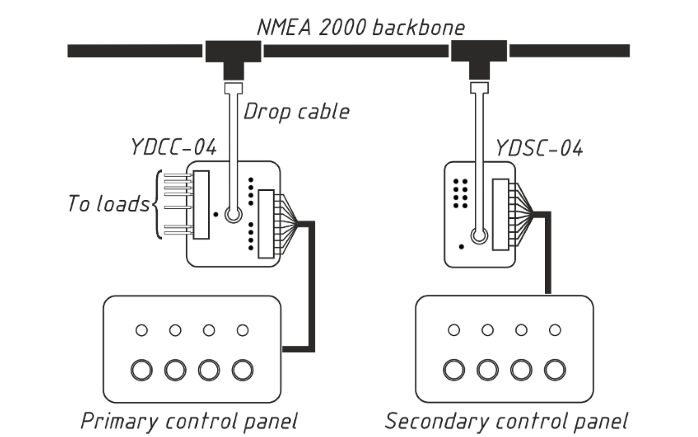
The Switch Control YDSC-04 is designed to set up additional control posts (see Figure 1) with duplicate physical buttons and LED indicators. It is compatible with other NMEA 2000 digital switching devices managed with standard NMEA 2000 PGNs 127501 and 127502.
Many digital switching systems require special button panels. You can connect any momentary push button (better with an integrated LED) to the Circuit Control or the Switch Control. It allows seamless integration to the existing boat interior.
The only thing you should know about the NMEA in your installation is that the devices working together must have the same "bank number" (all devices are supplied with zero number programmed), while independent digital switching systems on a single NMEA 2000 network must have different bank numbers (252 unique bank numbers are allowed in NMEA 2000). The bank number can be changed from the connected buttons or with any NMEA 2000 installer's software.
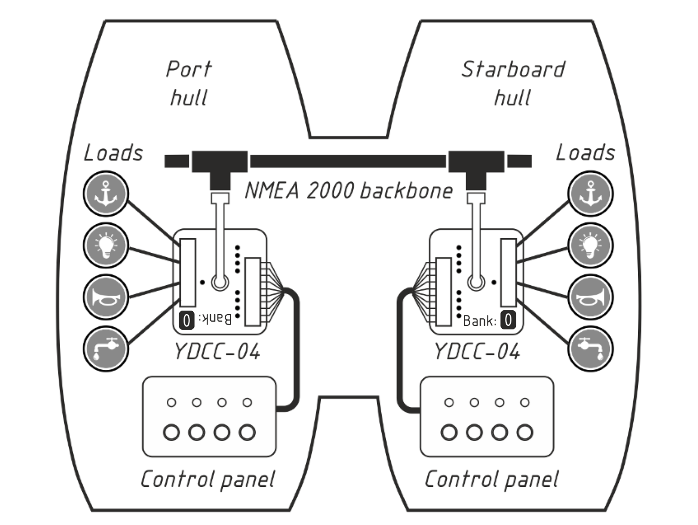
The Circuit Control unit can work in parallel with other units (see Figure 2) and can be managed from multiple Switch Control units with a matched bank number. Loads can also be managed from "virtual buttons" of Web Gauges , or automatically managed by our sensors .
If you have external access to your boat's Wi-Fi network, the NMEA 2000 Wi-Fi Gateway with built-in Web Gauges will allow you to manage loads from everywhere using a web browser on any device (smartphone, PC, tablet, etc.).
The Circuit Control and Switch Control use standard NMEA 2000 PGNs and are designed to be compatible with Oceanic Systems , Offshore Systems, Chetco Digital , Maretron (see p.27 in the Manual ) and Carling Tech displays and relay modules. To check whether your MFD is compatible, search the list of NMEA 2000 PGNs for numbers 127501 (in the "Receive" list) and 127502 (in the "Transmit" list).
UPDATE 13/12/2018 : Loads connected to the Circuit Control YDCC-04 can be managed from all chart plotters with CZone support : this includes all modern models of Garmin, B&G, Lowrance, Simrad, Furuno and recent models from Raymarine (Axiom, eS, gS series). Unfortunately, these messages are not supported in Garmin and Raymarine chartplotters.They use CZone and EmpirBus digital switching systems which have proprietary and not publicly available protocols. We hope that these NMEA leviathans will return to following the Standard, but we will also try to find a way to add compatibility mode in the new firmware updates. Both our devices can be upgraded from CAN Log Viewer connected to NMEA 2000 with Wi-Fi or USB Gateway .
UPDATE 06/12/2018 : The Circuit Control and Switch Control are certified by National Marine Electronics Association . The Circuit Control and Switch Control have been submitted for NMEA 2000 certification, and we expect that this will be passed by the end of this year.
Examples of digital switching systems are available on the Circuit Control page , while terminals and connectors of devices are described in the Appendix C of the Manual .
The Circuit Control (USD $289) and Switch Control (UDS $149) are in stock. To learn more or order products, visit the Circuit Control and Switch Control pages.
Next articles:
Previous articles:
See also: recent news , all news ...

IMAGES
VIDEO
COMMENTS
Circuit Control YDCC-04. The Circuit Control contains four latching (bi-stable) relays, which can be managed from connected control buttons with LED indicators or over NMEA 2000 with standard messages. ... (English version) of Circuit Control and other Yacht Devices digital switching products (Switch Control, smart sensors, Wi-Fi gateway) from ...
Circuit Control YDCC-04. The Circuit Control contains four latching (bi-stable) relays, which can be managed from connected control buttons with LED indicators or over NMEA 2000 with standard messages. The Circuit Control is the core component of our digital switching system. In addition to connected buttons, loads can be managed from modern ...
Version 1.11, released on July 22, 2024. Also contains copies of sounds 25-28 which can be overwrited by user in device's memory and sample of voice recordings. ZIP file, size is 278 KB. User Manual for Circuit Control and Switch Control. Covers models YDCC-04, YDSC-04. Firmware version 1.03. Document YDCCSC-04-003. February 18, 2019.
This Manual contains information on how to install, configure and operate Yacht Devices Circuit Control YDCC-04 (hereinafter Circuit Control) and Yacht Devices Switch Control YDSC-04 (hereinafter Switch Control) intended for use on leisure crafts. The Circuit Control and Switch Control (hereinafter, where the differences are not critical, Devices)
Figures 1-4. System examples. The Circuit Control unit can work in parallel with other units and can be managed from multiple Switch Control units with a matched bank number (252 unique bank numbers are allowed in NMEA 2000). Multiple independent digital switching systems (with different bank numbers) can co-exists in a single NMEA 2000 network.
This item: Yacht Devices Circuit Control - YDCC-04N . $289.00 $ 289. 00. Get it as soon as Saturday, Jun 29. Only 4 left in stock - order soon. ... Yacht Devices Boat Engine Gateway YDEG-04 for Volvo Penta, BRP Rotax and J1939 Engines to NMEA 2000 Marine Electronics Networks (NMEA 2000 (DeviceNet) Micro Male Connector) ...
The NMEA 2000 Circuit Control YDCC-04 from Yacht Devices allows digital switching of up to 4 AC/DC channels via latching relays from your chart plotter, web page or connected buttons. The NMEA 2000 Circuit Control YDCC-04 is the core of the digital switching system. As well as connected buttons, loads can be managed from modern chart plotters ...
Yacht Devices Circuit Control YDCC-04 - The Circuit Control contains four latching (bi-stable) relays, which can be managed from connected control buttons with LED indicators or over NMEA 2000 with standard messages. The Circuit Control is the core component of Yacht Devices digital switching system. In addition to connected buttons, loads can ...
The Yacht Devices YDCC-04N Circuit Control is a versatile NMEA 2000 compatible device featuring four latching (bi-stable) relays for efficient management of onboard electrical circuits. It allows control via connected buttons with LED indicators or through NMEA 2000 network messages, making it ideal for digital switching systems in marine ...
Yacht Device''sCircuit Control YDCC-04 contains four latching relays (AC and DC loads) which can be managed from connected buttons with LED indicators or over NMEA 2000 with standard PGNs 127501 and 127502.
The Switch Control allows viewing of the state and the management of four channels of an NMEA 2000 switch bank from the connected buttons with LED indicators. It is designed to work in tandem with Circuit Control YDCC-04 (contains four latching relays) and is compatible with other NMEA 2000 digital switching devices managed by standard NMEA ...
Yacht Devices Circuit Control YDCC-04N. It contains four latching (bi-stable) relays, which can be managed from connected control buttons with LED indicators or over NMEA 2000 with standard messages or from modern chart plotters with CZone support. This includes Garmin, Lowrance, Simrad, B&G, Furuno chart plotters and recent models from ...
The Switch Control allows viewing of the state and the management of four channels of an NMEA 2000 switch bank from the connected buttons with LED indicators. It is designed to work in tandem with Circuit Control YDCC-04 (contains four latching relays) and is compatible with other NMEA 2000 digital switching devices managed by standard NMEA ...
Yacht Devices Circuit Control NMEA 2000 Digital Switching YDCC-04 Description The Circuit Control unit has four latching (bi-stable) relays, which can be managed from connected control buttons with LED indicators or over NMEA 2000 with standard messages or from modern chart plotters with CZone support.
Yacht Devices NMEA 2000 Switch Control YDSC-04. The Switch Control allows viewing of the state and the management of four channels of an NMEA 2000 switch bank from the connected buttons with LED indicators. It is designed to work in tandem with Circuit Control YDCC-04 (contains four latching relays) or Alarm Button YDAB-01 and is compatible ...
The Switch Control allows viewing of the state and the management of four channels of an NMEA 2000 switch bank from the connected buttons with LED indicators. It is designed to work in tandem with Circuit Control YDCC-04 (contains four latching relays) or Alarm Button YDAB-01 and is compatible with other NMEA 2000 digital switching devices ...
A legendary military strategist, Shamil created a strict imamate that enforced Islamic laws and customs in the North Caucausus and managed to support a reserve army of 40,000 men. Resistance came ...
Just hours ahead of Vladimir Putin's annual address to the Russian parliament violence erupts in restive Chechnya
News that the primary suspects in the April 15 Boston Marathon bombings are of Chechen heritage resurrected interest in historically troubled Chechnya, an autonomous republic in Russia's North Caucasus Region. Suspects Dzhokhar and Tamerlan Tsarnaev's motive has yet to be confirmed, but questions abound about what role the ongoing violence between Russia and Chechen separatists might have ...
This Manual contains information on how to install, configure and operate Yacht Devices Circuit Control YDCC-04 (hereinafter Circuit Control) and Yacht Devices Switch Control YDSC-04 (hereinafter Switch Control) intended for use on leisure crafts. The Circuit Control and Switch Control (hereinafter, where the differences are not critical, Devices)
Yacht Devices. sailors for sailors. Menu. Products; Downloads; Support; Company; News; FAQ; Shop; Products; Downloads; Support; Company; Shop; Images of the Circuit Control YDCC-04 . Return to the Product. FAQ; Contact; Popular in FAQ. What type of device connector is suitable for my boat? FAQ: Installation and connectors; I do not have an NMEA ...
Russian targets. Cornered in Chechnya, the separatists took the war to Russia. Attacks throughout the country became a grim reality of the new war and involved explosions in cities and towns, on ...
December 6, 2018. New digital switching products. We are very pleased to present the Circuit Control YDCC-04 and the Switch Control YDSC-04. These devices have low power consumption and are cost effective and well suited to building a NMEA 2000 digital switching system on small and medium size vessels. The main key to successful sailing is ...